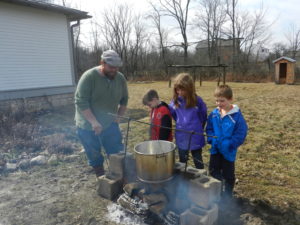 By Gabe Ross, Gallant Farm Manager
By Gabe Ross, Gallant Farm Manager
To some, late winter in Ohio means maple syrup time. I heard a tufted titmouse this morning; some people call it the sugar bird, because it often starts singing when the weather is right for sap to run. The ideal sap weather includes nights in the 20s, days in the 40s, and sunshine.
The first year I learned to make syrup I was working at Stratford Ecological Center and I had just broken my leg prior to the season. That ended up being a blessing in disguise because I got to learn how to run the evaporator and finish batches right away. Normally, without a broken leg, I would not have been assigned to the sugarhouse. Ever since then I can’t imagine a winter without making syrup.
Here at Gallant, we only tapped a couple of trees. Gallant Woods has quite a few small sugar maples but not a huge number of large ones. A tree must be about 12 inches in diameter to tap it; any smaller and the tree could be damaged. But I’ve got 11 of my own trees at home, so we have plenty of sap to boil down.
During the Great Depression and before, many Ohio farmers with a woodlot and some maples would use syrup as a source of income during the winter months when things were slower on the farm. Most farms used galvanized buckets with a slate top to keep rain from running in and diluting the sap. The sap was then collected in metal tanks often pulled on a sled behind horses. This watery sap was brought to a sugarhouse or sugar shack and boiled down to make syrup. It takes approximately 40 gallons of sap to make a gallon of maple syrup!
Come out to the farm tomorrow to see the whole process and learn how syrup can be made on a small scale at home, no broken leg required.






